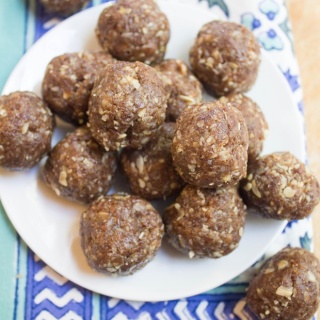A question that I get often from my nutrition clients, especially those who are runners, is: “How much protein should I eat?”
If you’ve ever questioned if you’re consuming enough protein as a runner, read on to learn the basics about protein, why you need more protein as an athlete, protein intake recommendations for the casual athlete (like me right now!) up to serious endurance/ultra runners, and my recent favorite protein-rich snack option.
Thank you to Gone Rogue for sponsoring this post!

Want to save this post?
Enter your email below and get it sent straight to your inbox. Plus, I'll send you great content every week!
How Much Protein Should You Eat Daily?
Before we get into the specifics of how much protein to eat each day, let’s first break down what protein is, and why it’s important, especially for runners!
What is protein?
Protein is made of building blocks called amino acids and contains the elements carbon, hydrogen, oxygen, and nitrogen.
It is a required macronutrient that plays several crucial roles in the body, but runners (and all athletes in general) need increased amounts of protein. More on that in a minute!
Functions of protein in the body:
- Protein is a structural part of bone, tendons, ligaments, organs, and skeletal muscle
- Transport proteins carry substances throughout the body
- Serum proteins assist in maintaining fluid and electrolyte balance
- Protein provides energy during prolonged endurance exercise
- Other regulatory proteins include enzymes to facilitate muscle/tissue repair and hormones that assist in energy metabolism
Choosing quality protein + high-quality protein sources
Protein quality is determined by its amino acid content and digestibility. In general, animal proteins are more digestible than plant sources. Twenty amino acids make up proteins, nine of which are essential (must be obtained through the diet) and eleven of which are non-essential (can be made by the body).
A protein is considered high-quality if it is easily digestible and is complete. Complete proteins are those foods that contain all of the nine essential amino acids.
Sources of animal-based complete proteins include dairy, eggs, fish, and meat. Plant-based sources of complete proteins include quinoa, soybeans, buckwheat, chia seeds, and hemp seeds.
An incomplete protein is lacking one or more of the essential amino acids.
Many plant proteins are classified as incomplete and must be combined to create a complete amino acid profile. For example, combining beans and rice or wheat bread and peanut butter creates a complete protein.
These complementary proteins don’t necessarily have to be consumed at the same time, though, as long as you are getting varied amino acid profiles from these foods throughout the day.
Do runners need more protein?
Distance runners in particular are at an increased risk of not eating enough protein. Having a low protein intake increases the risk of injury, fatigue, and even anemia in addition to suppressing the immune system. Consuming adequate amounts of protein is essential to make sure you are feeling and performing at your best!
Studies have found that oxidation of certain amino acids increased with training intensity, meaning that high-intensity training leads to an increased breakdown of amino acids (like leucine). So, if endurance athletes are using more protein during their workouts, they need to be eating more protein than the average person.
This is why you may notice that you crave more meat or other protein sources when you are training intensely. I know I definitely would find myself craving more protein-rich foods back when I was marathon training!
Not only does the endurance athlete need extra protein to replace oxidation of amino acids, but protein is also needed to help repair muscle damage from exercise. (Training leads to tiny tears in the muscle fiber that need to be repaired for you to become stronger and faster.)

How much protein runners really need
According to the Collegiate and Professional Sports Dietitians Association, athletes should shoot for 0.5 – 0.8 grams of protein per pound of body weight every day, with which end of the range you are on depending on how intensely you are training.
So for example if you are 170 pounds, you’d aim for somewhere between 85 and 136 grams of protein per day, with the lower end being the goal if you are a more casual runner and the higher end the goal if you are currently training more intensely.
You guys know I’m not a fan of calorie tracking or macro counting, so I don’t want you to stress yourselves out by calculating everything every day, but it’s worth doing a one-time assessment of your usual daily protein intake, especially if you are running a high volume of miles and including speed work, just to make sure that you are consistently taking in enough.
It’s generally enough to aim to consume some sort of protein source during each of your meals and snacks. Be sure to spread protein intake throughout the day rather than consuming large amounts at one time. Consuming more than 40 grams of protein at one time doesn’t lead to any extra benefits because it is not used by the body.
Timing of protein intake after a workout – does it matter?
Yes, the timing of protein intake after a run (or any exercise) matters!
It’s especially important to make sure to take in protein right after a workout – the optimal window for eating after a workout is about 30 – 45 minutes.
This recovery window is the best time to maximize skeletal muscle protein synthesis and replenish glycogen stores to help your body rebuild muscle and recover so you’re ready for the next workout. It’s also really important to eat right after a workout so you don’t find yourself having sugar cravings later on in the day due to under-fueling! (See also: What Causes Sugar Cravings?)
Protein-Rich Snack Ideas
I have found that getting enough protein at meals is relatively straightforward, but it can be tough to find snacks that are high in protein and also shelf-stable so you can take them on the go. I’m especially always looking for savory snacks that have protein, because I’d usually rather have a savory vs. a sweet snack!
Which brings me to: have you guys heard of Gone Rogue High Protein Chips?
They are high quality cuts of white meat chicken that have been smoked, sliced, baked, and seasoned to create a super crunchy, high protein chip. Cool idea, right? I love chips (huge fan of crunchy foods), so having an option that will actually keep me satisfied because it contains protein is awesome.

Gone Rogue is available in four flavors: Chicken Bacon, Chicken Teriyaki, Buffalo Style Chicken, and BBQ Flavored Chicken. The bacon and BBQ variations are my faves!
Each bag packs 17 grams of protein, making them a seriously filling snack. They are a great option for immediately post-run or workout if you know you won’t be able to have a full meal within an hour or so and need something to tide you over and help repair those muscles!
I also love having them on hand for on-the-go adventures. We brought some of the chips with us to the beach last month and it was nice to have an easy snack option to toss into my beach bag. They are also awesome on hikes and out on day-to-day adventures, too! I really love how crunchy they are.

You can find Gone Rogue High Protein Chips for purchase in their Amazon store. Give them a shot and let me know what you think!
As a runner, what are your favorite ways to get your protein throughout the day?
Any other runners find that as they increase mileage they immediately start craving more protein?
Other posts and resources that may be of interest:
- How to fuel a long run
- What to eat before and after a long run
- Top 5 Nutrition Mistakes Made by Runners
- How to Fuel for a Marathon or Half Marathon
- How to Become a Dietitian (+ How I Did It!)
- Intuitive Eating for Runners
- What Time Should You Stop Eating?
- How to Add Flavor to Meals Without Salt or Sugar






